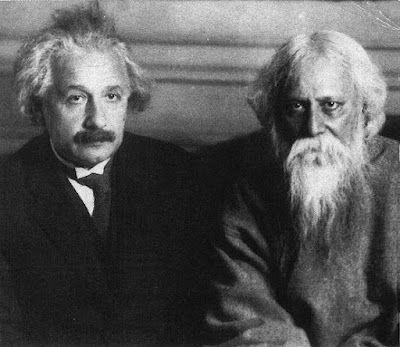टैगोर और आइंस्टीन: आध्यात्मिकता और विज्ञान को जोड़ते हुए (Tagore and Einstein: Bridging Spirituality and Science)
टैगोर और आइंस्टीन: आध्यात्मिकता और विज्ञान को जोड़ते हुए
 |
| टैगोर और आइंस्टीन |
Tagore and Einstein: Bridging Spirituality and Science
मानव विचार के क्षेत्र में, रवीन्द्रनाथ टैगोर और अल्बर्ट आइंस्टीन जैसे प्रतिष्ठित और प्रभावशाली कुछ ही व्यक्ति हुए हैं। जबकि प्रतीत होता है कि वे अलग-अलग दुनियाओं से आए हैं - भारत के एक प्रसिद्ध कवि, दार्शनिक और बहुज्ञ टैगोर, और आइंस्टीन, भौतिक विज्ञानी जिन्होंने ब्रह्मांड की हमारी समझ में क्रांति ला दी - उनके दर्शन एक आश्चर्यजनक प्रतिध्वनि साझा करते हैं।
विचारों का संगम:
टैगोर और आइंस्टीन की मुलाकात 1930 में हुई और उनकी बातचीत ने उनके विचारों के मिलन बिंदु पर प्रकाश डाला।
आइंस्टीन, जो भौतिकी में अपने क्रांतिकारी सिद्धांतों के लिए जाने जाते हैं, ने आध्यात्मिकता और मानव चेतना पर टैगोर के दृष्टिकोण में गहरी रुचि दिखाई।
दूसरी ओर, टैगोर ने आइंस्टीन के सिद्धांतों में सभी चीजों की परस्पर संबद्धता के बारे में अपनी मान्यताओं से गहरा संबंध पाया।
आध्यात्मिकता पर आइंस्टीन का दृष्टिकोण:
आइंस्टीन के वैज्ञानिक कार्यों ने ब्रह्मांड को देखने के हमारे तरीके को नया आकार दिया, फिर भी उन्होंने आध्यात्मिकता पर एक सूक्ष्म दृष्टिकोण रखा। उन्होंने प्रसिद्ध रूप से कहा, "धर्म के बिना विज्ञान लंगड़ा है, और विज्ञान के बिना धर्म अंधा है।" यह उद्धरण समझ की वैज्ञानिक खोज और अस्तित्व के गहन रहस्यों के बीच सामंजस्य में उनके विश्वास को रेखांकित करता है।
टैगोर का समग्र दर्शन:
रवीन्द्रनाथ टैगोर का दर्शन आध्यात्मिकता और प्रकृति के प्रति श्रद्धा में गहराई से निहित था। उनकी रचनाएँ, जैसे "गीतांजलि", सभी जीवन रूपों की एकता और व्यक्ति और ब्रह्मांड के बीच परस्पर क्रिया को खूबसूरती से व्यक्त करती हैं।
टैगोर ने खुले दिल और दिमाग के माध्यम से दुनिया का अनुभव करने के महत्व पर जोर दिया, जो आइंस्टीन के आश्चर्य और जिज्ञासा की भावना के आह्वान के साथ उल्लेखनीय रूप से मेल खाता है।
विज्ञान और आत्मा की एकता: जबकि आइंस्टीन के सापेक्षता के सिद्धांत और द्रव्यमान और ऊर्जा की समानता जैसे सिद्धांत आध्यात्मिकता से बहुत दूर लग सकते हैं, वे एक गहरी सच्चाई को प्रतिबिंबित करते हैं: सभी चीजों की परस्पर संबद्धता। जिस तरह टैगोर की कविता प्रकृति के साथ मानवता की एकता का जश्न मनाती है, आइंस्टीन के समीकरण ब्रह्मांड की अंतर्निहित एकता को प्रकट करते हैं।
द्वंद्व पर काबू पाना:
एक ऐसी दुनिया में जिसे अक्सर तर्कसंगत और रहस्यमय के बीच विभाजित माना जाता है, टैगोर और आइंस्टीन इन स्पष्ट विरोधाभासों को सुलझाने की दिशा में एक मार्ग प्रदान करते हैं। अस्तित्व के आश्चर्य और ज्ञान की खोज में उनका साझा विश्वास दर्शाता है कि मानव अनुभव वैज्ञानिक कठोरता और आध्यात्मिक अंतर्दृष्टि दोनों को शामिल कर सकता है।
निष्कर्ष: टैगोर के आध्यात्मिक ज्ञान और आइंस्टीन की वैज्ञानिक प्रतिभा का अभिसरण एक शक्तिशाली अनुस्मारक के रूप में कार्य करता है कि समझ की दिशा में मानव यात्रा बहुआयामी है। उन्होंने आध्यात्मिकता और विज्ञान के बीच जिस एकता की कल्पना की थी, वह हमें सीखने और अन्वेषण के लिए समग्र दृष्टिकोण अपनाने के लिए प्रोत्साहित करती है।
शिक्षकों के रूप में, सुनील सर की तरह, हम उनके उदाहरण से प्रेरणा ले सकते हैं, एक ऐसे माहौल को बढ़ावा दे सकते हैं जहां छात्र ब्रह्मांड का वर्णन करने वाले समीकरणों और उसकी भव्यता का जश्न मनाने वाली कविता दोनों में सुंदरता देखते हैं।
जीवन के वैज्ञानिक और आध्यात्मिक दोनों आयामों को अपनाकर, हम वास्तव में दुनिया के बारे में अपनी समझ को समृद्ध कर सकते हैं और सीखने को एक आनंददायक और ज्ञानवर्धक यात्रा बना सकते हैं।
For more details visit website
Title: Tagore and Einstein: Bridging Spirituality and Science
Introduction:
In the realm of human thought, there have been few figures as iconic and influential as Rabindranath Tagore and Albert Einstein. While seemingly coming from different worlds—Tagore, a renowned poet, philosopher, and polymath from India, and Einstein, the physicist who revolutionized our understanding of the universe—their philosophies share a surprising resonance. This article delves into how these two luminaries, though working in vastly different fields, managed to bridge the gap between spirituality and science.
The Confluence of Ideas:
Tagore and Einstein met in 1930, and their interactions highlighted the meeting point of their thoughts. Einstein, known for his revolutionary theories in physics, showed a keen interest in Tagore's perspectives on spirituality and human consciousness. Tagore, on the other hand, found in Einstein's theories a deep connection to his own beliefs about the interconnectedness of all things.
Einstein's View on Spirituality:
Einstein's scientific work reshaped the way we perceive the universe, yet he held a nuanced view on spirituality. He famously said, "Science without religion is lame, and religion without science is blind." This quote underscores his belief in the harmony between the scientific pursuit of understanding and the profound mysteries of existence.
Tagore's Holistic Philosophy:
Rabindranath Tagore's philosophy was deeply rooted in spirituality and a reverence for nature. His works, such as "Gitanjali," beautifully express the unity of all life forms and the interplay between the individual and the cosmos. Tagore emphasized the importance of experiencing the world through an open heart and mind, which aligns remarkably with Einstein's call for a sense of wonder and curiosity.
Unity of Science and Spirit:
While Einstein's theories like the theory of relativity and the equivalence of mass and energy may seem far removed from spirituality, they reflect a deeper truth: the interconnectedness of all things. Just as Tagore's poetry celebrates the unity of humanity with nature, Einstein's equations reveal the underlying unity of the universe.
Overcoming the Dichotomy:
In a world often perceived as divided between the rational and the mystical, Tagore and Einstein provide a path towards reconciling these apparent opposites. Their shared belief in the wonder of existence and the pursuit of knowledge showcases that the human experience can encompass both scientific rigor and spiritual insight.
Conclusion:
The convergence of Tagore's spiritual wisdom and Einstein's scientific brilliance serves as a powerful reminder that the human journey towards understanding is multifaceted. The unity they envisioned between spirituality and science encourages us to embrace a holistic approach to learning and exploration.
As educators, like Sunil Sir, we can draw inspiration from their example, fostering an environment where students see the beauty in both the equations that describe the cosmos and the poetry that celebrates its grandeur.
By embracing both the scientific and the spiritual dimensions of life, we can truly enrich our understanding of the world and make learning an enjoyable and enlightening journey.





Comments
Post a Comment